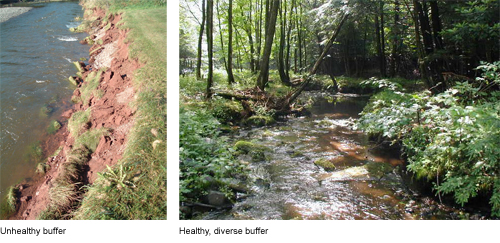|

This section provides more detailed information about the importance
of riparian buffers, instructions about streamside planting, a
list of Catskill native trees and shrubs and where to get them
and other guidance about proper management of the streamside area.
Click
here for a diagram about buffer functions
Click
here for more information about how to plant a buffer
Click here for the Catskill Streams Buffer Initiative Page - This program assists landownwers with technical and financial assistance for their riparian buffers.
Click here for a map of riparian buffer restoration projects as of December 31, 2009.
Native Trees, Shrubs and
Forbs (Grasses) for Different Purposes
Click on topics within the boxes below for a list of native plants
for various planting purposes.
Click
here for native plant vendor list
In addition to allowing the growth of diverse streamside buffers,
properly dispose of yard and household waste.
Unfortunately, some people think of streams as garbage dumps. Debris
can become a hazard during floods, and it can pose a threat to our
groundwater.
Remove old tires, garbage, and litter from your property and store
these materials as far from the stream as possible. Waste from pets
and livestock is a significant source excess nutrients and bacteria.
Dispose of your pet’s waste in the trash and store and livestock
manure properly. Finally, hazardous substance such as paints, thinners,
solvents, grease, oil, carpet cleaning water, pool and spa water
and detergents should not be dumped into streams, septics or stormwater
collection systems. Your town or county may sponsor a day (i.e.
Clean Sweep in Delaware County) to collect household hazard waste.
Using alternatives, or reusing and recycling hazardous fluids and
other products, can reduce the amount of waste produced in the first
place.
|
|

